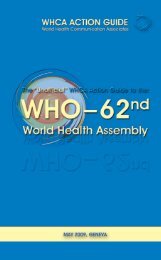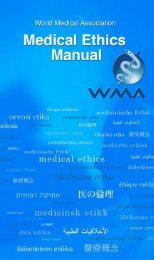the basics - World Health Communication Associates
the basics - World Health Communication Associates
the basics - World Health Communication Associates
- No tags were found...
You also want an ePaper? Increase the reach of your titles
YUMPU automatically turns print PDFs into web optimized ePapers that Google loves.
InterventionsA wide variety of initiatives have tried to enhance access to technologies and address<strong>the</strong> digital divide. These initiatives include <strong>the</strong> introduction of low-cost hardware; <strong>the</strong>creation of ‘staging posts’ where local intermediaries interpret information for o<strong>the</strong>rs;language-specific mirror sites (where web pages are regularly translated into locallanguages); and training programmes for users. Such technologies not only addressinformation access issues for users but can be useful to institutions and governmentsas an interactive way of ga<strong>the</strong>ring feedback on <strong>the</strong> friendliness of services andinformation access.One widely-used type of technology-based communication technique istelephone-delivered interventions (TDIs), in which counselling and health remindersare delivered using <strong>the</strong> telephone or through text messaging. TDIs can vary by <strong>the</strong>type of service provider and <strong>the</strong> extent to which <strong>the</strong> call is scripted. They may alsovary depending on characteristics and responses of <strong>the</strong> individual, and <strong>the</strong> extent towhich subsequent calls take into account information from o<strong>the</strong>r encounters with <strong>the</strong>individual (IOM 2002).A systematic review of technology-based communication techniques showsthat such decision aids improve knowledge, reduce decisional conflict and stimulatepatients to be more active in decision-making without increasing anxiety (O’Connoret al. 1999).New communication technologies offer educational opportunities tha<strong>the</strong>lp people to be more involved in <strong>the</strong>ir health decisions and treatment. Thesetechnologies include web-based learning, audio-visual aids (for example, videos,DVDs, spoken word), interactive games and ‘mobile health’ (m-health). Mobiledevices such as mobile telephones, as well as wireless and satellite communications,are giving remote communities an opportunity to be connected and have access toinformation. Two out of every three people on <strong>the</strong> planet now have access to mobile’phones. Sixty-four percent of all mobile ’phone users live in <strong>the</strong> developing world.By 2012, half of all residents in remote areas of <strong>the</strong> world will have mobile phones,compared with 305 million PCs or 11 million hospital beds. (Bloom & Woods 2010).The potential for m-health communications is enormous. M-health is a rapidlyevolving communication area and early results support its development as a mostpowerful interactive channel for health-related communications. Current usesfor m-health communication include citizen science (providing researchers withdata on risk promotion and behaviours), education and awareness, disease andSECTION 4: WHAT CAN WE DO TO STRENGTHEN HEALTH LITERACY? 37






